by Professor Ujjwal K Chowdhury
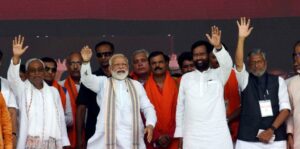
The latest defeat of BJP in Jharkhand polls has a lot to delve deep into to understand the reasons of the results and what message it has for the ensuing polls in the neighbouring two states of Bihar and Bengal.
- Jharkhand ‘Mahagathbandhan’s’ Arithmetic
The BJP failed to recognise the sheer arithmetic power of the JMM-INC-RJD alliance. It failed to understand that it had won in the 2014 elections primarily because JMM-Congress was contesting separately, and BJP was in partnership with AJSU. This time around, BJP was contesting alone, without AJSU, and the Opposition was united. Had the three parties contested together as an alliance in 2014, the BJP may not have won even in 2014. The alliance would have bagged 38 seats in 2014, just three short of majority.
The message for Bihar is that the right arithmetic in Bihar for the opposition alliance shall be to have RJD, Congress, HAM, the Left and Kushwaha group to be together and ensure there is a united Yadav-Muslim-Dalit-Peasants front as a challenger to BJP-JDU-LJP. The opposition parties need to go beyond skirmishes on seats and see the big picture and Lalu & Rahul Gandhi together can make the difference if they move beyond their past reservations. Keeping Kanhaiya Kumar in the alliance is an important factor too as much as Kushwaha and Jiten Majhi.
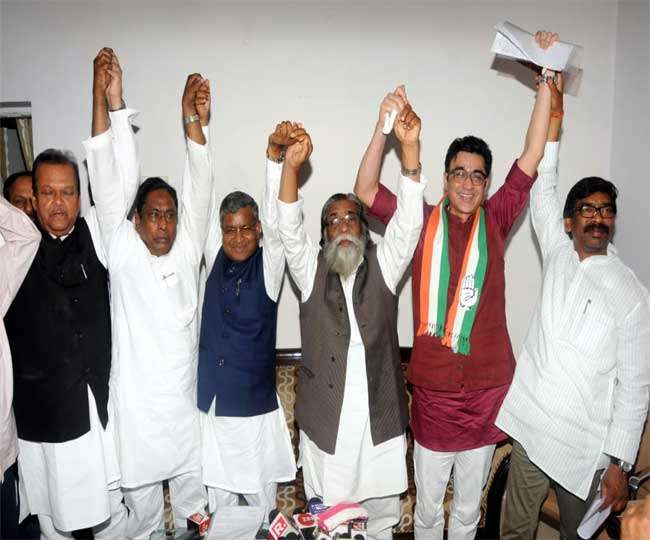
As for Bengal, TMC will naturally contest on its own, but having Congress with it in an alliance and allowing CPM/Left to contest without much hassles from TMC on ground in their very strong constituencies will be the right strategy. Even if Congress and the Left are together, the polarization in Bengal is bound to happen between TMC and BJP, and TMC would do well to allow Cong-Left to be the main challenger to BJP in their very strong seats. Focusing on strengths rather than thinly spreading has to be the focus of all non BJP forces.
- Seamless Transfer of Votes
The JMM-Cong-RJD alliance was primarily eyeing the Scheduled Tribe (ST)-Muslim-Yadav (MSY) vote bank which accounts for roughly half of the state’s population. The parties have successfully managed to transfer votes to each other without significant leakages. The alliance has been able to secure more than half of the Scheduled Tribe and Yadav votes, and almost three-fourth of the Muslim votes. STs hold the key to the assembly with more than one-third population in 45 out of 81 assembly seats in the state.
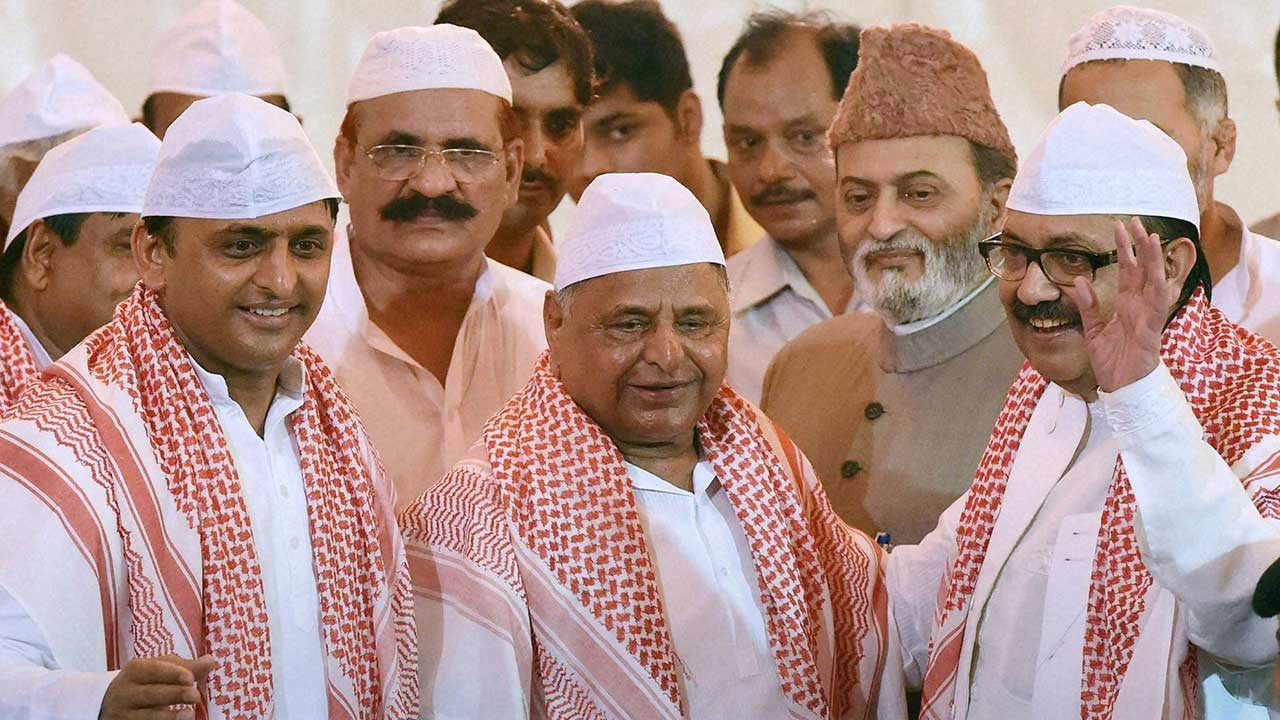
The seamless transfer of votes in Bihar needs to happen between RJD and Congress mainly which is not a given in the context of complex social alliances in the state. But focussing on falling economy and lack of good governance with the leadership question being sorted out in the opposition (facing Nitish Kumar from the ruling alliance) can yield results.
- BJP Faced the Wrath of Adivasis in Jharkhand
The BJP installed the state’s first non-tribal chief minister after its victory in 2014. It followed a similar policy of appointing a person from the non-dominant community as CM in three state elections which were held together: Haryana, Jharkhand and Maharashtra. This has angered the tribals. Some decisions of the Raghubar government further fuelled anger and increased tensions between the tribals and non-tribals of the state. Notable are filing sedition cases against 10,000 tribals of the Pathalgarhi movement, amendment of the Chotanagpur Tenancy Act and Santhal Pargana Tenancy Act which was seen as an attempt to acquire tribal land, and over 16,000 claims of tribals under the Forest Rights Act were reportedly rejected by Gram Sabhas.
There are palpable wrath of Muslims and Dalits in Bihar due to communal conflicts and upper caste atrocities. This is a major challenge coupled with poor governance, corruption charges and sex scandals as in Muzaffarpur shelter home, etc. These have to be channelized with an alternative vision and program, rectifying the issues of bias, discrimination, poverty, farm distress etc. by the opposition to earn the trust of the masses.
There is also a fit of palpable anger among Bengali electorate in the hinterland for the myriad corruption cases against lower level TMC functionaries. Didi Ke Balo direct connect program has been a reasonable success with more than 3 million calls and contacts made and the mass anger is down. The recent TMC victory in 3 bye-elections shows the tide is turning again after the Lok Sabha partial debacle of TMC. But some more major corrective measures, sops, outreach etc together can rectify it.
- Support Received by Parties from Various Castes / Communities
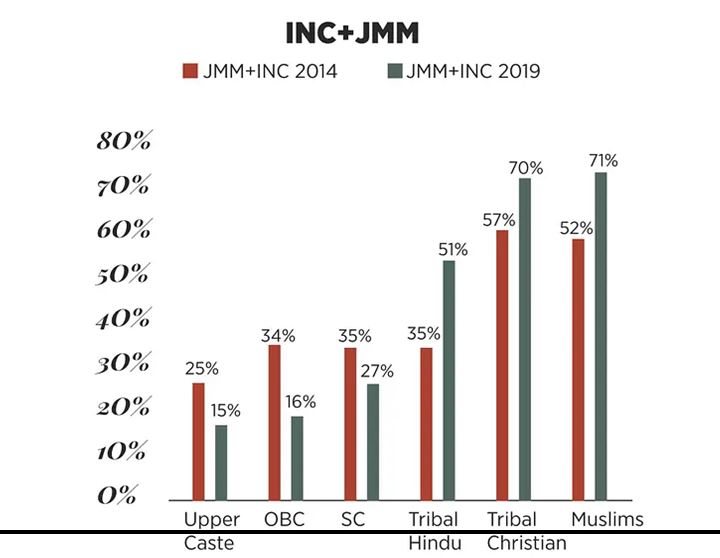
As a result of this, BJP’s tally declined from 11 in ST-reserved seats in 2014 to just two seats in the 2019 elections. The JMM-led alliance swept the reserved seats winning 25 out of 28 such seats this time around.
TMC in Bengal fared badly in tribal dominated seats like Jhargram etc and needs to take its welfare measures in the last 18 months of this tenure closer to the disgruntled poor people. Also the promise of citizenship to the Matua community, influencing at least 30+ assembly constituencies, through CAA, is a point in favour of BJP which TMC can counter only by explaining how NRC will again bring them in queues and to an uncertain future. They are already voters and Adhaar & ration card holders and that should suffice and the focus should be on developing their economic situation and not play politics on emotive issues.
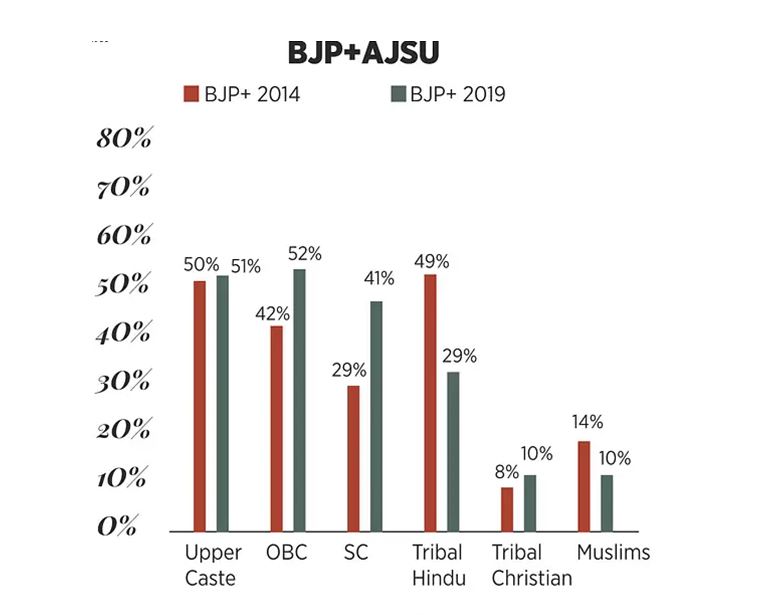
Bihar completely hinges upon Yadavs and Muslim voters of RJD effectively blending with Mahadalits of HAM, OBC voters of Kushwaha, upper caste support base of Congress and the peasants & youths rallied by the Left forces.
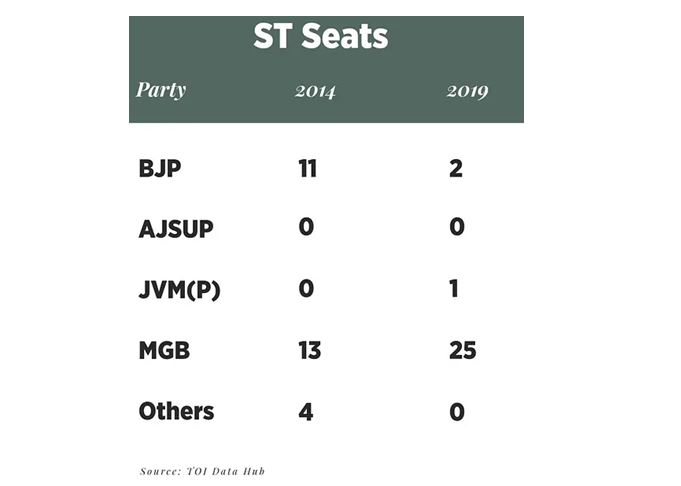
- A Lone AJSU Contesting Polls Couldn’t Split Opposition Vote
BJP split with its partner AJSU before the elections due to differences over seat-sharing. BJP didn’t want a repeat of Maharashtra where its ally would win some seats with BJP backing and end up with JMM in a hung assembly situation. It also hoped that AJSU would eat away some of the Opposition votes. BJP strategists expected AJSU to dent the ‘Mahagathbandhan’ vote bank as the party is essentially an offshoot of the JMM having presence among Kurmi / Mahato voters of the state. If BJP and AJSU had contested together they might have won 40 seats, just one short of majority. While AJSU did double its vote share from 3.7 percent to 8.1 percent, it wasn’t able to damage the ‘Mahagathbandhan’ candidates much. There was direct contest between AJSU and BJP in three seats, with BJP eventually winning these seats. AJSU finished as runners-up in another five seats where the ‘Mahagathbandhan’ candidates won. An alliance could have made a difference in these seats.
The lessons for both BJP and Gatbandhan in Bihar is to take care of their alliance partners with focused local support-base. BJP seems to be already one step ahead on this with JDU and LJP being cajoled post-Jharkhand, while Gatbandhan is yet to even begin its alliance-interactions. Except the Left, others are not even seen in the anti CAA-NRC movement, one reason being Nitish Kumar officially taking an anti-NRC stance under the pressures of Prashant Kishore and Pavan Kumar.
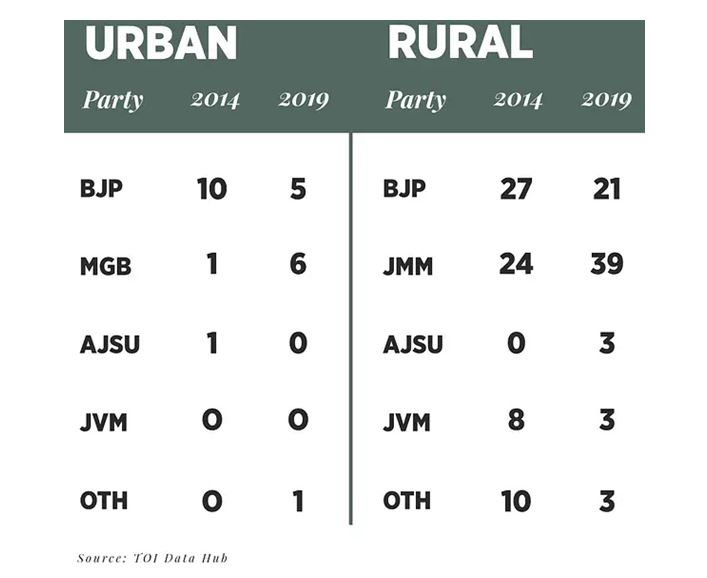
- Even Urban Centres Gave BJP the Thumbs Down
The urban voters across the country and especially in the Hindi heartland have backed the BJP for decades. National issues as well as the development agenda of the BJP appeals to this segment of voters. However, in these elections, the BJP has suffered a drubbing in the state’s urban centers as well. Its tally is down from 10 in 2014 to 5 in 2019. The Congress has made inroads winning three seats. The BJP’s sitting CM Raghubar Das himself lost the elections by 15000 votes from Jamshedpur (east) seat to the rebel candidate Saryu Roy. Unemployment, price rise, economic slowdown all seem to have contributed to this loss. The mining industry is facing severe pressure in the state, poor rains and droughts have led to a decline in the production of food grains. Agricultural distress and rural distress which have been plaguing the country for some time, have also impacted the BJP’s fortunes in the 69 rural seats. The party’s tally declined from 27 in 2019 to 21 in 2014.
This is a straight lesson that the opposing Gatbandhan and the ruling TMC can take for Bihar and Bengal polls respectively. Focus largely on economy, joblessness, farm distress, core sector fall etc largely, with talk on the vexed citizenship issue minimal and limited to its antithetic character with regards to the Constitution of India. Allowing BJP to take the control of the narrative and paint its opposition as merely pro-Muslim outfits (which they are trying hard in Bengal) would be to the detriment of the non-BJP forces.
- Voters Can ‘Distinguish’ Between Lok Sabha & Vidhan Sabha Polls
Just six months ago, BJP swept the Lok Sabha elections in Jharkhand, bagging 12 out of 14 seats, and recording more than 50 percent vote share. It was leading in 63 assembly seats. However, voters ‘punished’ Raghubar Das for anti-tribal policies. It lost around 18 percent vote share and ceded lead in more than half of the seats. While people voted Modi for development, they took to task Raghubar Das for non-performance. The national issues which Modi and Shah were raking up to deflect the attention of the voter from local issues, didn’t work.
Over the last few years, a new trend has emerged wherein BJP has been seen struggling to retain power in states where it is in power, including, Gujarat. The Modi factor doesn’t work alone in these cases; people demand actual performance as well. The Modi factor works well when the party is in opposition and it is able to present Modi’s track record as a harbinger of change.
This shall be the case in Bengal and Bihar also. Modi will not be the focus in Bihar, Nitish shall be and he is a weaker leader today. In Bengal, it will be Mamata, and hence she has to come out as a progressive, compassionate leader, and there are challenges in that as seen in recent times. Mamata image-makeover, which is now in progress under the supervision of election strategist Prashant Kishore, still has a long way to go.
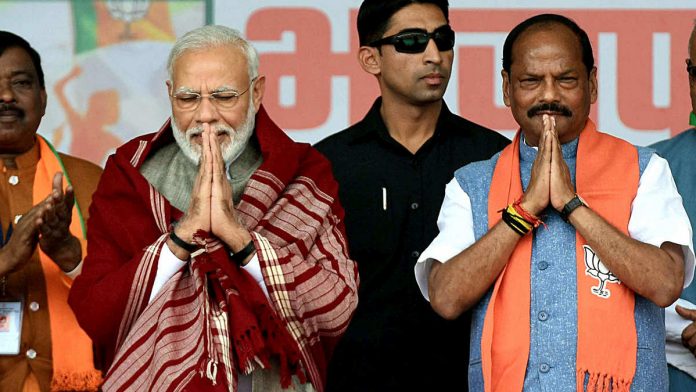
- Raghubar Das’s ‘Arrogance’ Harmed BJP
Raghubar consolidated all power within the Chief Minister’s Office. He played a key role in senior leaders like Saryu Roy being denied tickets. His strategy of poaching MLAs from the Opposition also backfired. In the end, Saryu Roy became the poster boy of these elections; his clean image denting the image of Raghubar Das and also the BJP. The main reasons for disgust of people against Raghubar Das in the state and also within his party: Favouritism to people close to him and side-lining people from other camps. This led to groupism in the party. RaghubarDas’s Son Lalit Das and brother Moolchand Sahu carry the image of goons with an ‘above the law’ attitude and have created a lot of nuisance in the city. From extortion of money from small business owners and vegetable vendors, to not paying at restaurants and threatening people and beating them up brutally etc. many such cases have come up but not registered. People have seen Raghubar Das and there is talk all throughout the city that he smokes up Marijuana and doesn’t participate in government works or is not available personally to listen to people’s problems and demands hefty amount as bribes. Raghubar Das has also been blamed for the deteriorating health scenario in the state and the pathetic condition of MGM Medical Hospital in Jamshedpur, RIMS and sadar units. Das is also blamed for failing in providing land ownership rights to the people of 86 slums in the steel city, not allowing land lease to these slums. Allegations of no tender getting passed without 8 percent commission to Raghubar Das.
These lessons are there for Nitish Kumar and Mamata Banerjee also with the issues differing. How much can Nitish ameliorate his image with polls less than a year away is an open question, but Mamata needs to rein administrative interference of her nephew Abhishek Banerjee, apart from cultivating a more approachable and people-friendly amicable image.
- Defectors Failed BJP
Five sitting MLAs of the JMM and Congress, and heavyweight leaders, Sukhdeo Bhagat, Manoj Yadav, Kunal Sarangi, Jai Prakash Patel, and Bhanu Pratap Shahi joined the BJP in October 2019 ahead of the Haryana and Maharashtra results. Out of these five, except for Bhanu Pratap Shahi, the other four all lost. Voters ‘punished’ these defectors.
Defections have been also from opposition forces in Bihar and from TMC in Bengal in recent times. Most detractors are returning to TMC while still some are there in BJP and TMC shall do it well by sharpening the differences between turncoats in BJP and the old guard of BJP. In Bihar, RJD and Congress will do it well to revamp their organizations and bring new and young blood at the top and quell further desertion.
- Lack of Innovation
Slogans help to catch people’s attention and change their perspective. BJP slogans lacked innovation and were repeating the same old slogans in with new coating. At the same time the opposition slogans were innovative, simple, catchy and complementing their manifesto. Slogans by BJP were Abkibaar, 65 paar; Abkibaar, phir se BJP sarkaar/Raghubarsarkaar.
Slogans by opposition were Modi tumse baeir Nahi, Raghubar Teri khair Nahi!, Jharkhand ki pukaar hai, Mahagatbandhan ki sarkaar hai, Hemant ab ki baar hai!, Badlosarkaar, Pao adhikar!, and Apke sapne karenge sakaar, Chalochale ab badle Sarkar!
–
Good lessons for RJD-Cong in Bihar and TMC in Bengal here. Didi key Bolo is a good innovation. But much more needed and almost every quarter till the polls. Slogans that hinge on absence of an accepted face in BJP in front of Mamata, on Mamata upholding the Hindu-Muslim united traditional Bengali identity, on BJP harping on religious identity when failing in economy, etc. RJD-Cong should focus on youth leadership (Tejaswi Yadav) and ideally Kanhaiya taken on board, as against a tired leader. Common minimum program of the gatbandhan should also give the other slogans. NYAY policy in Congress manifesto, not well communicated before Lok Sabha polls, could be a winning slogan too. Some of the Jharkhand opposition slogans are relevant for Bihar also.
- BJP In-fighting
BJP East Singhbhum general secretary Dinesh Kumar Sahu blamed “infighting”. “Perhaps people did not understand the development work done by our government and there was infighting among senior leaders which affected our candidates’ fortunes,” Sahu said. Raghubhar Das preferred his own people and slighted those perceived to be close to Arjun Munda. In Jamshedpur West, an important seat, Raghubhar Das posted debutant Devendra Nath Singh, his lawyer as a BJP Candidate against the experienced and known Banna Gupta of INC, resulting in a shameful loss for BJP. Banna Gupta would have surely lost if Saryu Rai was allowed to stand from his original seat of Jamshedpur West. This also resulted in Saryu Rai becoming a rebel leader and standing independently against Raghubhar Das, vowing to defeat the CM on his seat. Jharkhand BJP president Laxman Giluwa expelled 11 party leaders from Jamshedpur including former minister and Independent candidate from Jamshedpur East Saryu Roy from the party for six years for anti-party activities during second-phase of Assembly elections. Other leaders facing axe include Amarpreet Singh Kale, BarkunwarGagrai, Mukul Mishra, Satish Singh, Ratan Mahato, Hareram Singh, Rajnikant Sinha, Aseem Pathak, Ramnarayan Sharma, DhanurdharTripathy, Subodh Srivastava and Ramkrishna Dubey. Party has also ended the membership of Mahesh Singh, Dushyant Patel and Amit Yadav.
Among the expelled members of BJP are some prominent figures of the city that turned the tables and led to RaghubarDas’s defeat. Amarpreet Singh Kale is the president of Sardaar Association and motivated everyone from the community to vote against Das and to vote for Saryu Rai. Amarpreet Kale is known to be close to Arjun Munda &Saryu Rai. Ratan Mahato is an important link for Mahato votes, even he was sidelined. Mukul Misha being expelled made the Brahmin & Kshatriya community upset and vote for Saryu Rai. All these people are financially strong and fund the campaign but on being ousted from the party they used their might to destroy Das. Removing prominent party members and renowned leaders of the state in the middle of the elections put out the BJP in-fighting in the public. This also divided the votes and demotivated the party workers.
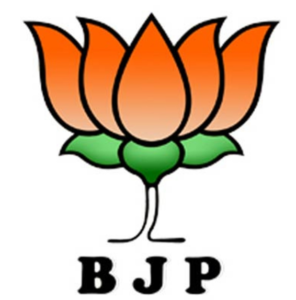
BJP’s internal dissent in Bengal (among TMC turncoats, old guard of BJP and RSS imports) is very well known and can be exploited well by TMC, if it can put its own house in better order. RJD and Congress in Bihar need morale booster that they can do it which should happen now with Jharkhand win and Lalu’s motivation from within the jail.
- Dependency on Modi
The secret of the party’s success over the last five and a half years can be credited to Modi’s persona and mass appeal. Prime Minister Modi’s personal political capital helped the party cross the finish line in two simultaneous general elections. However, Modi’s invincibility is now slowly emerging as the BJP’s weakness. Since much of the BJP’s workers and leaders have been leaning on the ‘Modi factor’ to help them sail through, this has also made them complacent. They’ve believed in – over the past five years – “Modi hai to Mumkin hai”.
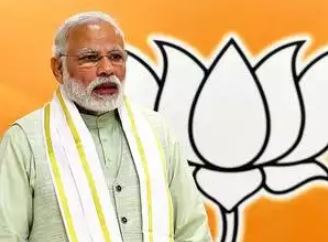
Modi charm can be effectively challenged if the focus of Bihar opposition and Bengal rulers is firmly on local leaders, issues, economics and challenges, and not the national ones or national leaders.
- Consolidation of power within CM office
Modi’s success has also impacted the style and functioning of BJP chief ministers. The resultant complacency has also caused these workers and leaders to lose touch with the people and ground realities. Many CMs are seen ‘copying’ Modi. They have big(ger) social media teams and run a PR/publicity blitz pre-election. The bureaucrats now run the show, and the CMs rely more on external strategists rather than workers and leaders. This has led to is the CMs losing touch with leaders and workers, and also with the public.A top-down approach doesn’t augur well for a cadre-based party like the BJP.
Mamata has this problem too and she must take active measures to decentralize government and political power down the line, keeping top leadership firmly in her hands. Tejaswi’s challenge is to acquire the leadership charisma which he still lacks.
- National Issues Vs. Local Issues
Modi’s strategy of running state election campaigns on central issues rather than on local issues has made the local leaders and workers complacent. “Modi hai, jita hi dega!” BJP only focused and raised national issues in Jharkhand where Congress raked up local issues and it worked in favour of Congress. BJP had done the same thing in Maharashtra and failed; it was not going to work in Jharkhand either. BJP did not take a lesson from it and still focused on National issues which did not resonate with the people.
Modi may not be the ultimate draw in Bihar and Bengal too if the challengers of BJP there learn the Jharkhand lessons and keep the focus firmly on ground and on local issues.
To sum up, the results show that the voter is distinguishing between state and national elections, evaluating each government on its merit, punishing CMs for non-performance, and is smart enough to not fall into the trap of the politics of deflection. The BJP now needs a serious rethink of its strategy and must develop strong regional leaders with mass appeal, to reduce dependence on the Modi factor.
The author is an awarded academic, a regular columnist and a television debater on issues related to education, politics and international affairs.





























